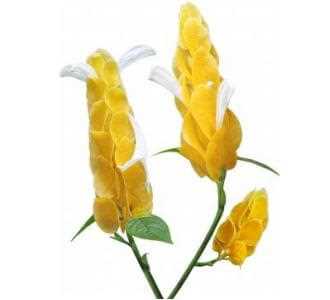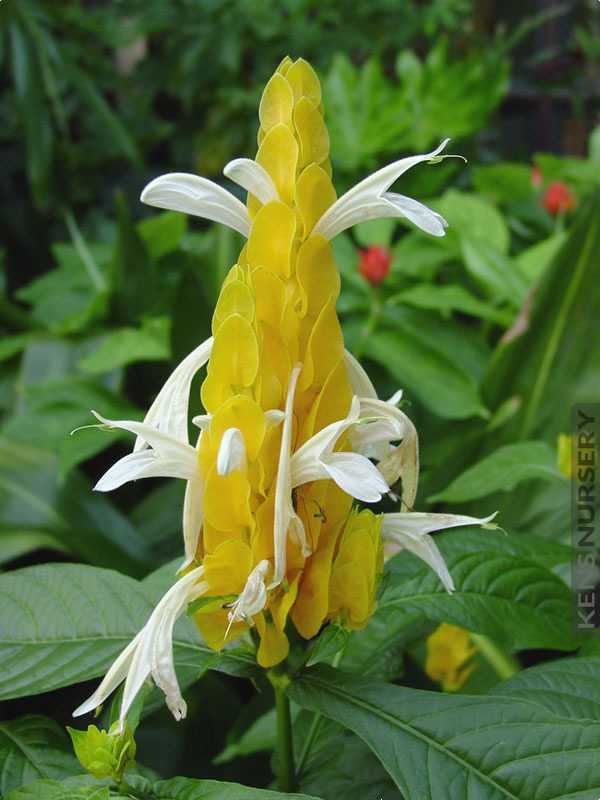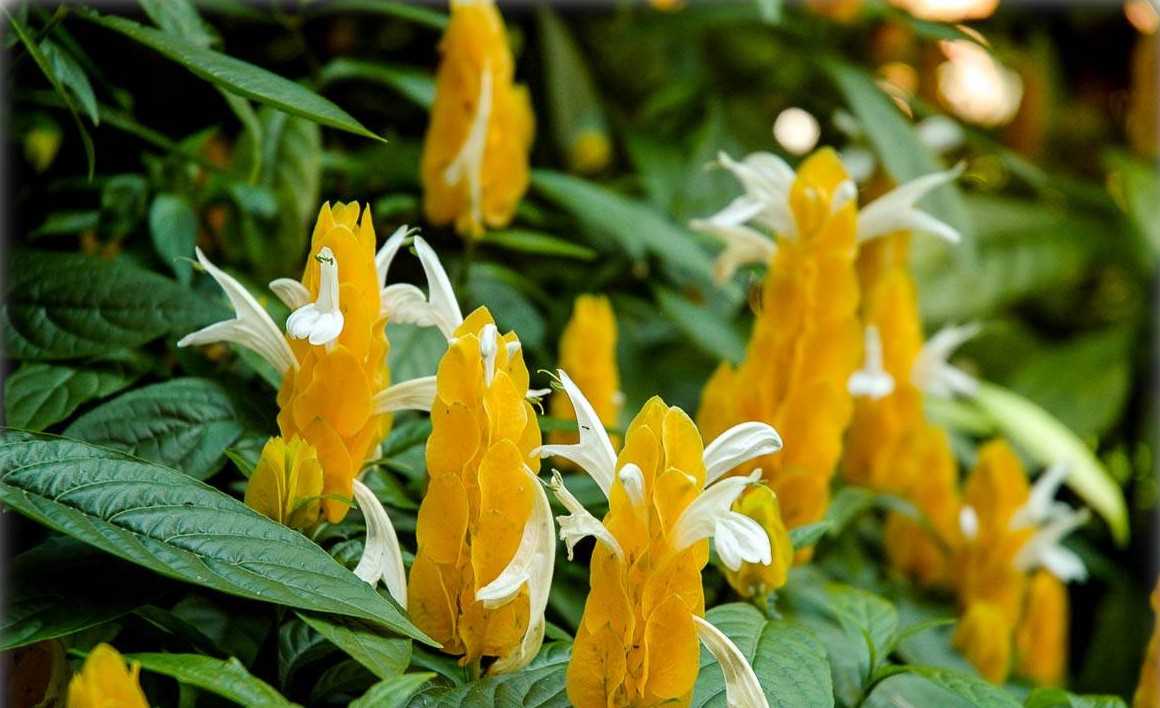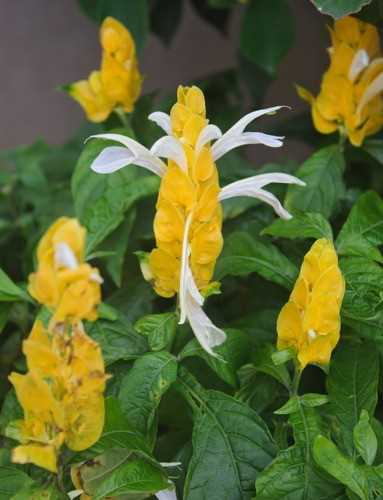- Tips for Caring for Pachystachys Plants at Home
- 1. Light Requirements
- 2. Temperature and Humidity
- 3. Watering
- 4. Fertilizing
- 5. Pruning
- 6. Propagation
- 7. Common Issues
- 8. Toxicity
- Understanding Pachystachys
- Appearance
- Care Tips
- Choosing the Right Location
- Light
- Temperature
- Humidity
- Watering
- Soil
- Providing Adequate Sunlight
- Watering and Humidity Requirements
- Fertilizing Pachystachys
- 1. Choose the right fertilizer
- 2. Follow the label instructions
- 3. Apply the fertilizer during the growing season
- 4. Use a slow-release fertilizer
- 5. Water thoroughly after fertilizing
- 6. Adjust the fertilization frequency
- 7. Avoid over-fertilization
- Pruning and Propagation Techniques
- Pruning Pachystachys
- Propagation Methods
- Common Pests and Diseases
- Species Guide: Different Types of Pachystachys
- 1. Pachystachys lutea
- 2. Pachystachys coccinea
- 3. Pachystachys lindenii
- 4. Pachystachys nebazia
- 5. Pachystachys luischornii
- 6. Pachystachys edulis
- Q&A:
- What is Pachystachys?
- Where do Pachystachys plants come from?
- Are Pachystachys plants easy to care for?
- What are the basic care requirements for Pachystachys plants?
- Do Pachystachys plants require high humidity?
- How often should I water my Pachystachys plant?
- Can I propagate Pachystachys plants?
- Video: Pachystachys lutea – grow & care (Shrimp plant)
Pachystachys, also known as the Lollipop Plant or Golden Shrimp Plant, is a stunning tropical plant that can add a touch of exotic beauty to any home. With its vibrant, colorful bracts and lush foliage, it’s no wonder these plants are becoming increasingly popular among plant enthusiasts. If you’re considering adding a Pachystachys to your indoor garden, here are some essential tips to help you care for and maintain these stunning plants.
Light: Pachystachys plants thrive in bright, indirect light. They can handle some direct sunlight, but too much can scorch their leaves. Place your plant near a window that receives filtered light, or provide artificial lighting if needed.
Watering: Pachystachys plants prefer to be kept evenly moist, but not soaking wet. Water your plant when the top inch of soil feels dry to the touch, and make sure to provide good drainage for excess water. Avoid overwatering, as this can lead to root rot.
Humidity: Pachystachys plants love humidity and will thrive in a humid environment. Consider using a humidifier or placing a tray of water near your plant to increase humidity levels. Misting the leaves occasionally can also help increase humidity.
Temperature: Pachystachys plants prefer warm temperatures between 60-80°F (15-27°C). Avoid exposing your plant to temperatures below 55°F (12°C) as they are sensitive to cold.
Fertilizing: Feed your Pachystachys plant with a balanced liquid fertilizer every 2-4 weeks during the growing season (spring and summer). Follow the instructions on the fertilizer packaging for proper dosing.
Pruning: To keep your Pachystachys plant looking neat and tidy, prune any dead or faded bracts and trim back leggy growth. This will promote new growth and help maintain the plant’s shape.
Pests: Watch out for common indoor plant pests such as aphids and spider mites. Inspect your plant regularly and treat any infestations promptly to prevent damage.
Propagation: Pachystachys plants can be propagated through stem cuttings. Take a cutting from a healthy, mature plant and place it in moist soil or water until roots develop. Once roots have formed, you can transfer the cutting to a pot with well-draining soil.
With proper care and attention, your Pachystachys plant will reward you with its stunning beauty and vibrant colors. Follow these tips and enjoy the eye-catching presence of these tropical wonders in your own home.
Tips for Caring for Pachystachys Plants at Home
1. Light Requirements
Pachystachys plants prefer bright indirect light, so it’s best to place them near a window where they can receive filtered sunlight. Avoid placing them in direct sunlight as it can scorch their leaves.
2. Temperature and Humidity
These plants thrive in warm temperatures between 65-85°F (18-29°C). They also prefer high humidity levels, so consider placing them in a bathroom or misting their leaves regularly to create a humid environment.
3. Watering
Pachystachys plants like to be kept evenly moist but not overly wet. Water them when the top inch of soil feels dry to the touch. Make sure to water them thoroughly, allowing excess water to drain from the bottom of the pot.
4. Fertilizing
During the growing season, which is typically spring and summer, you can fertilize your Pachystachys plants once a month with a balanced houseplant fertilizer. Follow the instructions on the fertilizer packaging for the appropriate dosage.
5. Pruning
Regular pruning can help maintain the shape and size of your Pachystachys plant. Remove any dead or yellowing leaves, as well as any leggy or overgrown stems. Pruning also encourages new growth and can help prevent diseases and pests.
6. Propagation
Pachystachys plants can be propagated through stem cuttings. Take a cutting from a healthy stem, remove the lower leaves, and place it in a pot with moist soil. Keep the cutting warm and moist, and roots should start to develop within a few weeks.
7. Common Issues
Some common issues you may encounter with Pachystachys plants include yellowing leaves, which can indicate overwatering or lack of sunlight, and pests such as aphids or mealybugs. Monitor your plants regularly and take appropriate action if you notice any problems.
8. Toxicity
Pachystachys plants are non-toxic to humans and pets, making them a safe choice for households with children or animals. However, it’s always a good idea to keep any plant out of reach of curious pets or young children.
| Light | Temperature | Watering | Fertilizing | Pruning | Propagation | Common Issues | Toxicity |
|---|---|---|---|---|---|---|---|
| Bright indirect light | 65-85°F (18-29°C) | Keep evenly moist | Once a month during growing season | Regular pruning to maintain shape | Propagate through stem cuttings | Yellowing leaves, pests | Non-toxic to humans and pets |
Understanding Pachystachys
Pachystachys, also known as the Lollipop Plant or Golden Shrimp Plant, is a genus of tropical flowering plants native to Central and South America. These stunning plants are known for their vibrant, shrimp-like flower bracts that come in various shades of red, orange, and yellow. They are popular as indoor and outdoor ornamental plants, adding a beautiful touch of color to any space.
Appearance
Pachystachys plants are characterized by their large, ovate leaves that are dark green in color and can grow up to 6 inches long. The most striking feature of these plants is their flowers, which are actually modified leaves called bracts. The bracts form around small, inconspicuous flowers and resemble vibrant shrimp or lollipop-shaped structures, hence the common names of the plant.
Care Tips
Here are some care tips for keeping your Pachystachys plants healthy and thriving:
- Light: Pachystachys plants prefer bright, indirect light. They can tolerate some morning or evening sun, but direct sunlight during the hottest part of the day can scorch their leaves.
- Temperature: These plants thrive in warm temperatures between 65-80°F (18-27°C). They can tolerate some fluctuations in temperature, but it’s best to keep them away from cold drafts.
- Watering: Pachystachys plants like to be kept evenly moist. Water them thoroughly when the top inch of soil feels dry, but make sure to avoid overwatering as it can lead to root rot.
- Humidity: These plants prefer high humidity, so misting them regularly or placing a humidifier nearby can help maintain optimal humidity levels.
- Fertilization: Feed your Pachystachys plants with a balanced, water-soluble fertilizer every month during the growing season (spring and summer) to promote healthy growth and vibrant flowers.
- Pruning: Remove any yellow or dead leaves or flowers to keep your plant looking tidy. You can also trim back any leggy growth to encourage a bushier appearance.
Pachystachys plants are generally low-maintenance, but they do require some care to ensure their optimal growth and blooming. By providing them with the right conditions and regular attention, you can enjoy the beauty of these stunning plants in your own home.
Choosing the Right Location
When it comes to caring for Pachystachys plants, one of the most important factors to consider is choosing the right location. These stunning plants thrive in warm, tropical environments, so it’s important to mimic those conditions as closely as possible in your home.
Light

Pachystachys plants require bright, indirect light to thrive. They should be placed near a window where they can receive ample sunlight throughout the day. However, direct sunlight should be avoided as it can scorch the leaves and cause them to turn yellow or brown.
Temperature
These plants thrive in warm temperatures between 65°F (18°C) and 85°F (29°C). They should be kept away from drafts or areas with fluctuating temperatures, as this can stress the plant and affect its growth. It’s also important to keep the humidity levels high, as Pachystachys plants prefer a humid environment.
Humidity
Pachystachys plants require high humidity to thrive. To increase the humidity around the plant, you can place a tray of water near it or use a humidifier. Misting the leaves regularly can also help maintain the desired humidity levels.
Watering
Proper watering is crucial for the health of Pachystachys plants. They prefer consistently moist soil, but not waterlogged. Allow the top inch of soil to dry out before watering again. It’s important to water the plant thoroughly, ensuring water reaches the roots. Avoid letting the plant sit in standing water, as this can lead to root rot.
Soil
Pachystachys plants prefer well-draining soil that retains moisture. A mixture of peat moss, perlite, and sand is ideal for these plants. Avoid using heavy clay soils, as they can retain too much moisture and lead to root rot.
By choosing the right location for your Pachystachys plant and providing it with the proper care, you can enjoy the beauty of these stunning plants in your home for years to come.
Providing Adequate Sunlight

Pachystachys plants require adequate sunlight to thrive and produce vibrant blooms. Here are some tips for providing the right amount of sunlight for your Pachystachys:
- Indirect sunlight: Pachystachys plants prefer bright, indirect sunlight. They should be placed near a window with filtered light or in a well-lit room without direct exposure to the harsh rays of the sun.
- Avoid direct sunlight: Direct sunlight can scorch the leaves of the Pachystachys plant, leading to sunburn and damage. Make sure to shield your plant from direct sunlight by using sheer curtains or placing it in a location where it receives indirect light.
- Rotate the plant: To ensure even exposure to sunlight, rotate the Pachystachys plant every few weeks. This will prevent the plant from leaning towards the light source and promote uniform growth.
- Monitor for signs of light deficiency or excess: If your Pachystachys plant is not receiving enough sunlight, you may notice weak growth, pale leaves, or fewer blooms. On the other hand, if it is exposed to too much sunlight, the leaves may turn yellow or brown, and the plant may become dehydrated. Adjust the amount of sunlight accordingly.
By providing the right amount of sunlight, you can ensure that your Pachystachys plants thrive and showcase their stunning foliage and blooms.
Watering and Humidity Requirements
Pachystachys plants have specific watering and humidity needs to thrive in your home. Here are some tips to keep them healthy:
- Watering: Pachystachys plants prefer moist but not waterlogged soil. It is important to water them thoroughly, allowing the water to drain out of the bottom of the pot. However, make sure to let the top inch or two of soil dry out between waterings to prevent overwatering which can lead to root rot.
- Humidity: These plants thrive in high humidity environments. To increase humidity, you can place a tray with water near the plant or use a humidifier. Misting the leaves with water regularly can also help to provide the necessary moisture.
- Temperature: Pachystachys plants prefer temperatures between 65°F (18°C) and 75°F (24°C). Avoid exposing them to extreme fluctuations in temperature or drafts, as it can damage the plant.
- Lack of humidity: If the air in your home is dry, you may notice the edges of the leaves turning brown or crispy. Increasing the humidity around the plant can help prevent this issue.
- Signs of underwatering: If the leaves of your Pachystachys plant start to wilt or become droopy, it may be a sign that it needs more water. However, be careful not to overwater, as this can lead to root problems.
- Signs of overwatering: If the leaves of your Pachystachys plant turn yellow or develop black spots, it may be a sign of overwatering. Check the moisture level of the soil and adjust your watering accordingly.
By following these watering and humidity guidelines, you can ensure that your Pachystachys plant thrives and displays its stunning flowers for a long time.
Fertilizing Pachystachys
Pachystachys plants require regular fertilization to thrive and produce stunning blooms. Here are some tips for fertilizing your Pachystachys:
1. Choose the right fertilizer

When selecting a fertilizer for your Pachystachys, choose one that is high in nitrogen, as this will promote healthy leaf growth. Look for a balanced fertilizer with a ratio of 10-10-10 or 20-20-20.
2. Follow the label instructions
Always read and follow the instructions on the fertilizer label. This will ensure that you apply the correct amount and prevent over- or under-fertilization, which can harm your Pachystachys.
3. Apply the fertilizer during the growing season
Apply fertilizer to your Pachystachys during the active growing season, which is typically in spring and summer. This is when the plant requires the most nutrients to support its growth and flowering.
4. Use a slow-release fertilizer
A slow-release fertilizer can provide a steady supply of nutrients to your Pachystachys over a longer period of time. This can help prevent nutrient imbalances and reduce the risk of fertilizer burn.
5. Water thoroughly after fertilizing
After applying fertilizer, make sure to water your Pachystachys thoroughly. This will help distribute the nutrients evenly and prevent the roots from becoming burned by concentrated fertilizer.
6. Adjust the fertilization frequency

Monitor your Pachystachys closely to determine its fertilizer needs. If the plant shows signs of nutrient deficiency, such as pale leaves or stunted growth, increase the frequency of fertilization. If the plant appears healthy and is growing well, you can reduce the frequency.
7. Avoid over-fertilization
While fertilizing is important, it is crucial to avoid over-fertilization as this can cause harm to your Pachystachys. Over-fertilization can lead to burnt roots, nutrient imbalances, and decreased plant health. Always follow the recommended dosage on the fertilizer label.
By following these tips, you can ensure that your Pachystachys receives the proper nutrients to grow and thrive, resulting in stunning displays of blooms.
Pruning and Propagation Techniques
Pruning Pachystachys
Pachystachys plants benefit from regular pruning to maintain their shape and promote healthy growth. Here are some tips on how to prune your Pachystachys:
- Prune your plant in early spring before new growth begins.
- Start by removing any dead, yellow, or damaged leaves and stems. Use clean, sharp pruning shears to make clean cuts.
- Trim back any overly long or straggly branches to maintain a compact and bushy appearance.
- Remove any faded or spent flowers to encourage the plant to produce new blooms.
Regular pruning will help keep your Pachystachys plant healthy and prevent it from becoming leggy or overgrown.
Propagation Methods
If you’re interested in propagating your Pachystachys plants, here are a few methods you can try:
- Root Division: Pachystachys plants can be divided during repotting. Carefully remove the plant from its pot and gently separate the root ball into two or more sections. Make sure each section has roots attached. Replant the divisions in separate pots, and water thoroughly.
- Stem Cuttings: Take stem cuttings from a healthy Pachystachys plant in early spring using clean, sharp pruning shears. Cut a 4-6 inch section of a stem just above a leaf node. Remove the lower leaves and dip the cut end into rooting hormone. Plant the cutting in a well-draining potting mix, keep it moist, and place it in a warm, bright location. Roots should develop within a few weeks.
- Leaf Cuttings: This method is less common but can be successful with Pachystachys. Select a healthy leaf and cut it into 2-3 inch sections. Insert the cut ends into a well-draining potting mix, ensuring that the bottom half of each cutting is buried. Keep the cuttings moist and place them in a warm, bright location. Roots should develop within a few weeks.
Propagation can be a rewarding way to expand your Pachystachys collection or share plants with friends and family.
Common Pests and Diseases
- Aphids: One common pest that can infest Pachystachys plants is aphids. These small, soft-bodied insects suck sap from the leaves, causing them to become distorted and yellow. To control aphids, you can use insecticidal soap or a strong spray of water to wash them off the plant.
- Whiteflies: Whiteflies are another pest that can cause damage to Pachystachys plants. They are small, white insects that feed on the plant’s sap and can transmit diseases. To prevent and control whiteflies, you can use sticky traps, introduce natural predators like ladybugs, or use insecticidal soap.
- Spider mites: Spider mites are tiny pests that are not actually insects, but rather members of the arachnid family. They feed on the underside of leaves, causing yellow spots and webbing. To get rid of spider mites, you can use insecticidal soap or horticultural oil, and make sure to regularly mist the leaves to increase humidity.
- Fungal diseases: Pachystachys plants can be susceptible to fungal diseases such as powdery mildew and root rot. Powdery mildew appears as a white, powdery substance on the leaves, while root rot causes the roots to become soft and brown. To prevent fungal diseases, avoid overwatering, provide good air circulation, and remove any infected plant parts.
- Leaf spots: Leaf spots can be caused by various fungal or bacterial pathogens, resulting in small, brown or black lesions on the leaves. To prevent leaf spots, avoid overhead watering, remove any infected plant parts, and provide proper care to keep the plant healthy.
Species Guide: Different Types of Pachystachys
Pachystachys, also known as the Lollipop Plant or Golden Shrimp Plant, is a genus of tropical flowering plants native to Central and South America. There are several different species of Pachystachys, each with its own unique characteristics and care requirements. Here are some of the most popular types of Pachystachys:
1. Pachystachys lutea
Pachystachys lutea, commonly known as the Golden Shrimp Plant, is one of the most popular species of Pachystachys. It is known for its vibrant yellow bracts that resemble shrimp. This plant prefers bright, indirect light and requires high humidity to thrive. Pachystachys lutea can grow up to 3 feet tall and makes a stunning addition to any tropical or exotic garden.
2. Pachystachys coccinea
Pachystachys coccinea, also called the Red Shrimp Plant or Scarlet Spiral Flag, is another beautiful species of Pachystachys. It features eye-catching red bracts that resemble shrimp. This plant requires similar care as Pachystachys lutea, preferring bright, indirect light and high humidity. With proper care, Pachystachys coccinea can reach a height of 2 to 3 feet.
3. Pachystachys lindenii
Pachystachys lindenii, commonly known as the Ginger Torch or Lollipop Plant, is a species of Pachystachys that stands out with its unique arrangement of red and yellow bracts. It prefers bright, indirect light and moderate humidity. Pachystachys lindenii can grow up to 4 feet tall and is often used as a decorative plant in tropical gardens or as a cut flower in floral arrangements.
4. Pachystachys nebazia
Pachystachys nebazia, also known as the Orchid Shrimp Plant, is a captivating species of Pachystachys that features long-lasting white bracts with purple spots. It requires similar care as other Pachystachys species, preferring bright, indirect light and high humidity. Pachystachys nebazia can grow up to 2 to 4 feet tall and is often grown as an ornamental plant for its unique flowers.
5. Pachystachys luischornii
Pachystachys luischornii, commonly known as the Chilean Firecracker Plant, is a species of Pachystachys that stands out with its fiery red tubular flowers. It thrives in bright, indirect light and prefers high humidity. Pachystachys luischornii is a compact plant that grows up to 1 to 2 feet tall and is often used as a border plant or in container gardens.
6. Pachystachys edulis
Pachystachys edulis, also called the Jambo Shrimp Plant, is a species of Pachystachys known for its large, edible fruits. It features yellow bracts with white flowers and requires similar care as other Pachystachys species. Pachystachys edulis can grow up to 3 to 4 feet tall and is often grown for its ornamental value as well as for its fruits.
These are just a few examples of the different types of Pachystachys available. Each species has its own unique beauty and care requirements, but they all share a love for tropical climates and high humidity. Whether you choose the Golden Shrimp Plant, the Red Shrimp Plant, or any other variety, Pachystachys plants are sure to bring a touch of tropical elegance to your home or garden.
Q&A:
What is Pachystachys?
Pachystachys is a genus of tropical flowering plants that are known for their stunning and unique flowers.
Where do Pachystachys plants come from?
Pachystachys plants are native to tropical regions of Central and South America.
Are Pachystachys plants easy to care for?
Yes, Pachystachys plants are generally easy to care for as long as their basic needs are met.
What are the basic care requirements for Pachystachys plants?
Pachystachys plants require bright indirect light, warm temperatures, regular watering, and well-draining soil.
Do Pachystachys plants require high humidity?
Yes, Pachystachys plants prefer high humidity and benefit from regular misting or placement in a humid environment.
How often should I water my Pachystachys plant?
Pachystachys plants should be watered when the top inch of soil feels dry, which is usually about once a week.
Can I propagate Pachystachys plants?
Yes, Pachystachys plants can be propagated through stem cuttings. Simply cut a healthy stem below a node, remove the lower leaves, and place the cutting in water or moist soil until roots develop.
Video:
Pachystachys lutea – grow & care (Shrimp plant)







